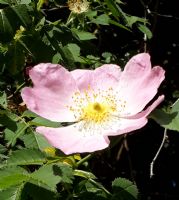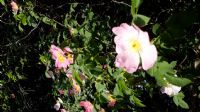|
The Dog Rose (Rosa Canina)
Back to Nature news

Dog rose
© FNRC
The Dog Rose (Rosa Canina)
Date added: 30/05/2020 10:36:31
Author: Joan Stacey
This month we are looking at that most iconic of English flowers, the Dog Rose. There is uncertainty about the origin of its name but it may go back to ancient Roman times when it was thought to cure the bite from a mad dog or possibly it means that this rose is of lower value than others. This is probably the plant Shakespeare referred to as ‘eglantine’ in his Midsummer Night’s Dream.
The plant can grow to 16ft. and has small, sharp, curved thorns which enable it to climb up other plants. Its five-petalled flowers vary from deep pink to white and have a mild but unmistakable and evocative fragrance. The thorns also act as a defence against being eaten by animals.
It can claim to be useful as well as lovely as it provides nectar for pollinating insects and increases their populations so that we benefit when these pollinate our food crops.
In autumn, the bright red fruits called ‘hips’ are eaten by birds preparing for winter which means the seeds are widely dispersed to grow into new plants.
The fleshy part of the fruit can be used to make a type of marmalade, rose hip tea and syrup. Notably in WW 2, the fruit was collected, often by schoolchildren, for its usefulness in treating and preventing scurvy which results from lack of Vitamin C
Horticulturists use the wild plant as vigorous ‘stock’ for grafting on most newly developed roses.
It yields a very attractive fine- grained wood which is prized for wood turning and for small items of furniture.
The political significance of this rose dates back to the Wars of the Roses, around 1455, when the Houses of York and Lancaster adopted the white and red roses respectively as their symbols. When the two houses united, the Tudor Rose combined both colours to became symbolic of peace.
Unfortunately, the dog roses in the cemetery are behind the Lodge and can not be seen while the cemetery is still closed to the public. The photograph was taken in one of the Friends’ gardens.
© FNRC
Images related to this news article
-

Dog rose
© Joan Stacey
|




